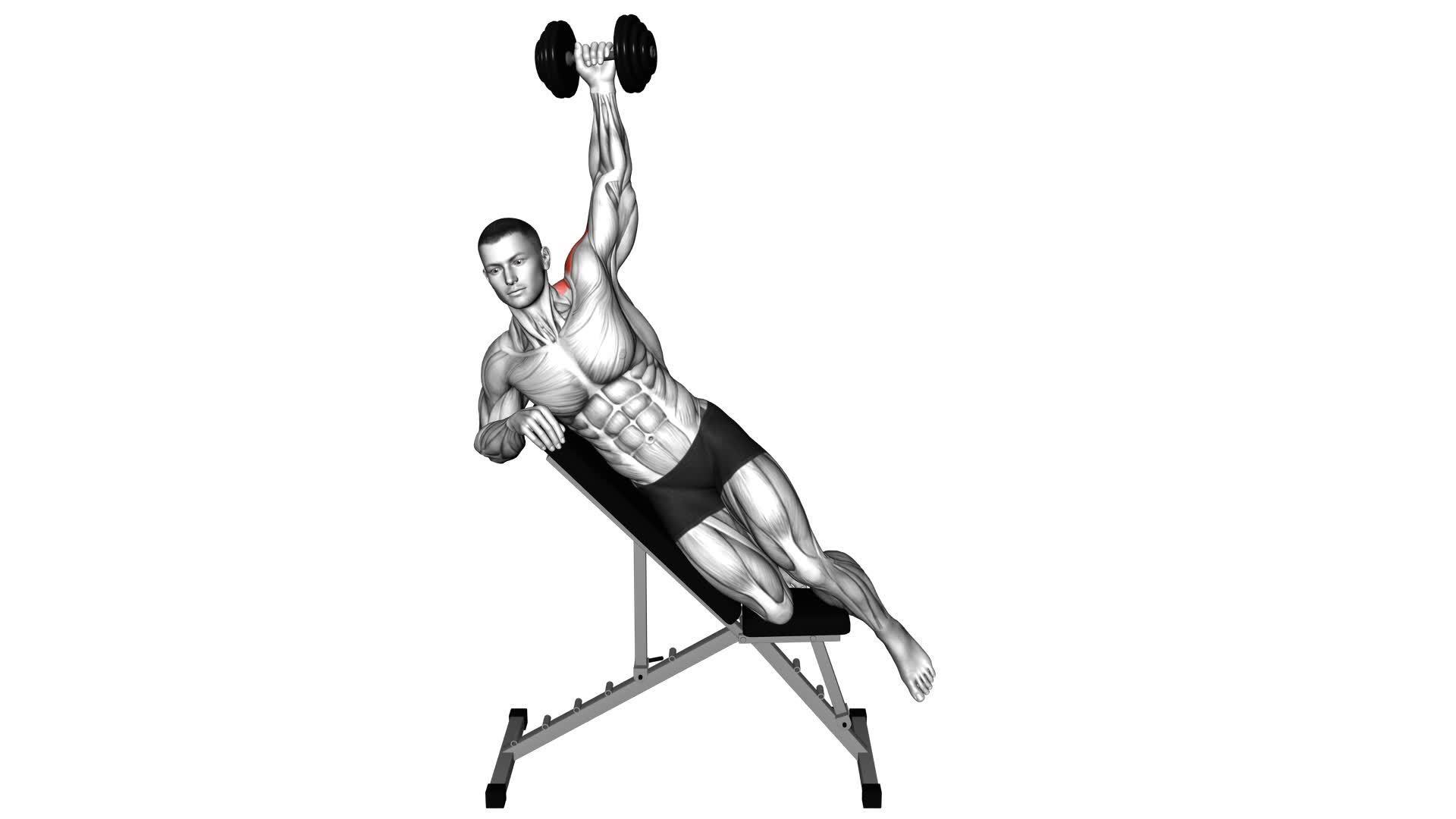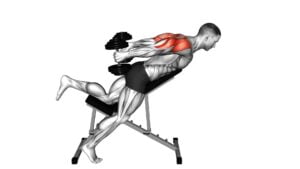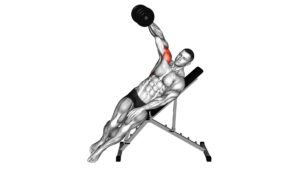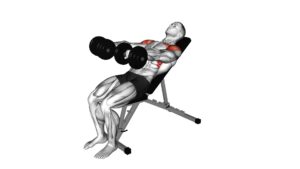Dumbbell Incline Powell Raise (male) – Video Exercise Guide & Tips

Looking to strengthen your upper body and sculpt your shoulders? The Dumbbell Incline Powell Raise is the exercise for you.
Watch This Exercise Video
In this video exercise guide, we'll show you the proper form and technique to maximize your results. With variations and progressions available, you can tailor this workout to your fitness level.
Avoid common mistakes and get the most out of your workout with our expert tips.
Get ready to raise the bar on your upper body workout!
Key Takeaways
- Targets posterior deltoids, rhomboids, and trapezius muscles
- Improves upper body strength and posture
- Encourages proper form and controlled movement
- Reduces the risk of injury
Benefits of Dumbbell Incline Powell Raise
You can achieve significant shoulder and upper back strengthening with the Dumbbell Incline Powell Raise. This exercise targets the posterior deltoids, rhomboids, and trapezius muscles, helping to improve overall upper body strength and posture. One of the benefits of performing the Dumbbell Incline Powell Raise is that it encourages proper form. By positioning yourself on an incline bench and using dumbbells, you can maintain a stable and controlled movement throughout the exercise. This not only maximizes the effectiveness of the workout but also reduces the risk of injury.
In addition to the physical benefits, it's important to note the role of nutrition in optimizing your results. To support muscle growth and recovery, it's essential to fuel your body with the right nutrients. Adequate protein intake is particularly crucial as it provides the building blocks for muscle repair and growth. Incorporating lean proteins, complex carbohydrates, and healthy fats into your diet can help enhance your performance and maximize the benefits of the Dumbbell Incline Powell Raise.
Now that you understand the benefits of this exercise and the importance of nutrition, let's move on to the equipment and setup required for performing the Dumbbell Incline Powell Raise.
Equipment and Setup for the Exercise
To properly execute the Dumbbell Incline Powell Raise, you'll need the following equipment and setup.
- An incline bench set at a 45-degree angle will provide the necessary support for your back while performing the exercise.
- Additionally, you'll need a pair of dumbbells with an appropriate weight for your fitness level. It's recommended to start with lighter weights and gradually increase as you gain strength and confidence.
Before starting the exercise, ensure that the incline bench is stable and secure. Adjust the seat height, if possible, to maintain proper form throughout the movement. Sit on the bench with your feet planted firmly on the ground and your back fully supported against the backrest.
Next, hold the dumbbells in each hand with an overhand grip. Position your arms straight down, perpendicular to the floor, and your palms facing your body. This is the starting position for the Dumbbell Incline Powell Raise.
It is important to maintain a slight bend in your elbows throughout the exercise to avoid strain on your joints. With control, lift the dumbbells up and out to the sides, keeping your arms straight. Continue the movement until your arms are parallel to the floor.
Remember to engage your shoulder muscles and avoid using momentum or swinging the weights. Lower the dumbbells back to the starting position in a controlled manner.
Proper Form and Technique
When performing the Dumbbell Incline Powell Raise, it's crucial to maintain proper form and technique to effectively target your shoulder muscles. The importance of shoulder stability can't be overstated in this exercise.
To begin, lie on an incline bench with a dumbbell in each hand, palms facing down. Keep your feet firmly planted on the ground, ensuring stability throughout the movement.
As you raise the dumbbells, focus on engaging your shoulder muscles and maintaining a controlled motion. Avoid using momentum or swinging your arms, as this can reduce the effectiveness of the exercise and increase the risk of injury.
To maximize muscle activation, squeeze your shoulder blades together at the top of the movement. This will further engage your shoulder muscles and promote better stability.
Remember to exhale as you lift the dumbbells and inhale as you lower them back down. By practicing proper form and technique, you can effectively target your shoulder muscles and achieve optimal results from the Dumbbell Incline Powell Raise exercise.
Variations and Progressions
To progress the Dumbbell Incline Powell Raise and add variation to your shoulder workout, incorporate different weights or resistance bands into the exercise. This will challenge your muscles in new ways and help you continue to make gains. Here are four variations and modifications you can try:
- Increase the weight: Start by using lighter dumbbells and gradually increase the weight as your strength improves. This will target your shoulder muscles more effectively and promote muscle growth.
- Resistance bands: Instead of using dumbbells, you can use resistance bands to perform the Incline Powell Raise. The bands provide constant tension throughout the movement, engaging your shoulder muscles and enhancing stability.
- Alternating arms: Perform the exercise by raising one arm at a time instead of both together. This variation won't only target your shoulder muscles but also engage your core for stability.
- Incline bench angle: Adjust the angle of the incline bench to target different areas of your shoulder muscles. A higher incline will emphasize the front deltoids, while a lower incline will target the side deltoids.
Common Mistakes to Avoid
To perform the Dumbbell Incline Powell Raise correctly, make sure to avoid common mistakes such as keeping your elbows too wide and selecting the incorrect weight.
When your elbows are too wide, you risk putting unnecessary strain on your shoulders and reducing the effectiveness of the exercise.
Additionally, choosing the wrong weight can lead to improper form and potential injury.
Elbows Too Wide
Avoid positioning your elbows too wide during the Dumbbell Incline Powell Raise for optimal form and effectiveness. When your elbows are too wide, it can compromise your technique and increase the risk of shoulder injuries. Here are four reasons why you should avoid this common mistake:
- Improving Technique: Keeping your elbows slightly tucked in helps to engage the correct muscles, such as the anterior deltoids and upper chest. This ensures that you're targeting the intended muscle groups effectively.
- Preventing Shoulder Injuries: Positioning your elbows too wide places excessive stress on the shoulder joint, increasing the risk of strains or impingements. By keeping your elbows closer to your body, you maintain proper alignment and reduce the strain on your shoulders.
- Maintaining Stability: Having your elbows too wide can make it challenging to stabilize the weights during the exercise. Keeping your elbows tucked in provides better control and stability throughout the movement.
- Optimizing Range of Motion: When your elbows are wide, it limits your range of motion, making it harder to fully extend and contract your muscles. By keeping your elbows closer, you can achieve a fuller range of motion, maximizing the benefits of the exercise.
Incorrect Weight Selection
Weight selection is crucial to ensure that you perform the exercise correctly and effectively. Using too light of a weight may not provide enough resistance to engage the targeted muscles, while using too heavy of a weight can lead to poor form and potential injury. It's important to find a weight that allows you to complete the exercise with proper technique, maintaining control throughout the movement.
If you find that the weight you initially chose is too heavy or too light, don't hesitate to modify it. Remember, the goal is to challenge yourself while maintaining proper form to maximize the benefits of the Dumbbell Incline Powell Raise.
Tips for Maximizing Results
To maximize your results with the Dumbbell Incline Powell Raise, it's important to focus on proper form. This exercise targets specific muscles, so make sure you're performing it correctly to get the most out of it.
Additionally, don't forget about the role of nutrition and recovery in achieving your goals. Fuel your body with the right nutrients and give yourself enough time to rest and recover between workouts.
Lastly, consistency is key. Stick to a regular exercise routine and stay committed to seeing progress over time.
Proper Form Importance
To achieve maximum results from the Dumbbell Incline Powell Raise, it's crucial to maintain proper form throughout the exercise. Proper technique is essential for targeting the intended muscles and preventing injuries.
Here are four important tips to ensure you perform the exercise correctly:
- Keep your back flat against the bench: This helps maintain stability and engage the targeted muscles effectively.
- Use controlled movements: Avoid swinging or using momentum to lift the dumbbells. Slow and controlled movements ensure proper muscle engagement.
- Maintain a slight bend in your elbows: Fully extending your arms can put unnecessary stress on your joints. Keep a slight bend to protect your elbows.
- Focus on the mind-muscle connection: Concentrate on contracting your shoulder muscles as you lift the dumbbells. This will maximize the effectiveness of the exercise.
Nutrition and Recovery
To maximize your results and aid in recovery, it's important that you prioritize proper nutrition and rest.
Nutrition plays a crucial role in supporting your workouts and helping your muscles recover. Make sure to fuel your body with a balanced diet that includes lean proteins, complex carbohydrates, and healthy fats. Aim to consume enough calories to support your activity level and promote muscle growth.
Additionally, hydration is key for optimal recovery. Drink plenty of water throughout the day to replace fluids lost during exercise.
In terms of recovery methods, consider incorporating strategies like foam rolling, stretching, and getting enough sleep to allow your muscles to repair and rebuild.
By taking care of your body through proper nutrition and recovery, you can maximize your results and achieve your fitness goals.
Now, let's move on to the next section about why consistency is key.
Consistency Is Key
Maintaining a consistent workout routine is essential for maximizing your results and achieving your fitness goals. Consistency allows your body to adapt and improve over time, leading to increased strength, endurance, and overall fitness.
Here are four key tips to help you stay consistent and get the most out of your workouts:
- Set realistic goals: It's important to set goals that are attainable and realistic. This will help you stay motivated and focused on your progress, rather than getting discouraged by unrealistic expectations.
- Be patient: Rome wasn't built in a day, and neither is a fit and healthy body. It takes time for your body to change and for results to show. Patience is key when it comes to sticking to your workout routine and seeing long-term results.
- Create a schedule: Plan your workouts in advance and stick to a consistent schedule. This will help you establish a routine and make it easier to stay committed to your fitness goals.
- Find enjoyment in the process: Consistency becomes easier when you enjoy what you're doing. Find activities and exercises that you genuinely enjoy, whether it's weightlifting, swimming, or dancing. This will make it more likely for you to stick to your routine and see the results you desire.
Frequently Asked Questions
How Many Sets and Reps Should I Do for the Dumbbell Incline Powell Raise?
To get the most out of the dumbbell incline Powell raise, it's important to know how many reps and sets are recommended. This exercise targets your shoulders and upper back, so you want to make sure you're doing it correctly.
Start with a weight that challenges you but still allows for proper form. Aim for 3-4 sets of 8-12 reps, resting for 60-90 seconds between sets.
Remember to keep your core engaged and lift the dumbbells in a controlled manner for optimal results.
Can I Use a Resistance Band Instead of Dumbbells for This Exercise?
Yes, you can definitely use a resistance band instead of dumbbells for the dumbbell incline powell raise exercise.
Using resistance bands for upper body exercises is a great way to add variety and challenge to your workout routine.
It allows you to target the same muscles but with a different form of resistance.
You can experiment with different variations of the dumbbell incline powell raise using resistance bands to keep your workouts interesting and effective.
Is It Necessary to Incline the Bench While Performing the Dumbbell Incline Powell Raise?
Yes, it's necessary to incline the bench while performing the dumbbell incline Powell raise.
Incline bench exercises offer several benefits for upper body workouts. The incline position targets the upper chest muscles, shoulders, and triceps more effectively. It also helps to engage the core muscles for stability.
To perform the exercise correctly, lie on the incline bench, hold the dumbbells with your palms facing each other, and raise them to shoulder level while keeping your elbows slightly bent.
Can Beginners Perform the Dumbbell Incline Powell Raise?
Yes, beginners can perform the dumbbell incline Powell raise. It's a great exercise for beginners as it targets the shoulders and helps build upper body strength.
The incline bench position allows for better isolation of the muscles and helps prevent cheating or using momentum.
The benefits of this exercise for beginners include improved shoulder stability, increased muscle definition, and enhanced overall upper body strength.
Are There Any Alternative Exercises That Target the Same Muscle Groups as the Dumbbell Incline Powell Raise?
When looking for alternative exercises to target the same muscle groups as the dumbbell incline powell raise, there are a few options you can try.
Incorporating exercises such as the dumbbell incline front raise, dumbbell lateral raise, or cable lateral raise can provide similar benefits. These exercises can help strengthen and tone your shoulders, specifically targeting the front and side deltoids.
Adding the dumbbell incline powell raise into your workout routine can help improve shoulder stability and overall upper body strength.
Conclusion
In conclusion, the dumbbell incline powell raise is a fantastic exercise for targeting and strengthening the shoulder muscles. With the right equipment and proper form, this exercise can be highly effective in building upper body strength.
By avoiding common mistakes and incorporating variations, individuals can maximize their results and continue progressing in their fitness journey. Remember to consult with a trainer or healthcare professional before attempting any new exercise.
Keep pushing yourself and enjoy the benefits of this challenging and rewarding exercise.

Author
Years ago, the spark of my life’s passion ignited in my mind the moment I stepped into the local gym for the first time. The inaugural bead of perspiration, the initial endeavor, the very first surge of endorphins, and a sense of pride that washed over me post-workout marked the beginning of my deep-seated interest in strength sports, fitness, and sports nutrition. This very curiosity blossomed rapidly into a profound fascination, propelling me to earn a Master’s degree in Physical Education from the Academy of Physical Education in Krakow, followed by a Sports Manager diploma from the Jagiellonian University. My journey of growth led me to gain more specialized qualifications, such as being a certified personal trainer with a focus on sports dietetics, a lifeguard, and an instructor for wellness and corrective gymnastics. Theoretical knowledge paired seamlessly with practical experience, reinforcing my belief that the transformation of individuals under my guidance was also a reflection of my personal growth. This belief holds true even today. Each day, I strive to push the boundaries and explore new realms. These realms gently elevate me to greater heights. The unique combination of passion for my field and the continuous quest for growth fuels my drive to break new ground.







